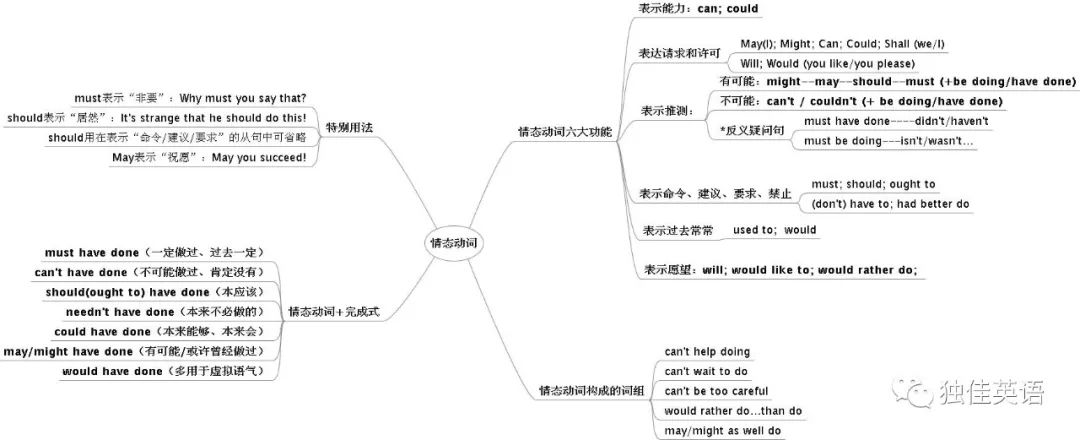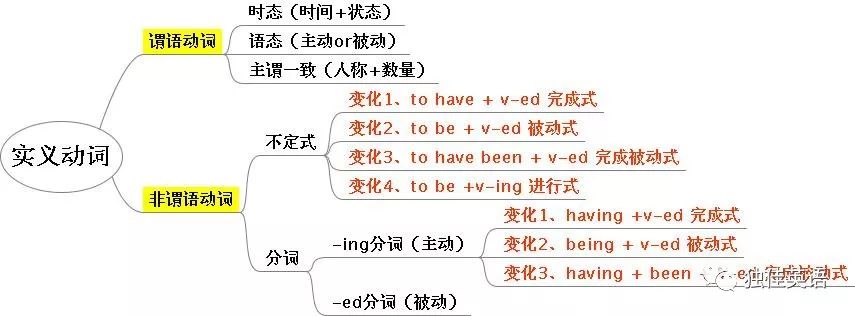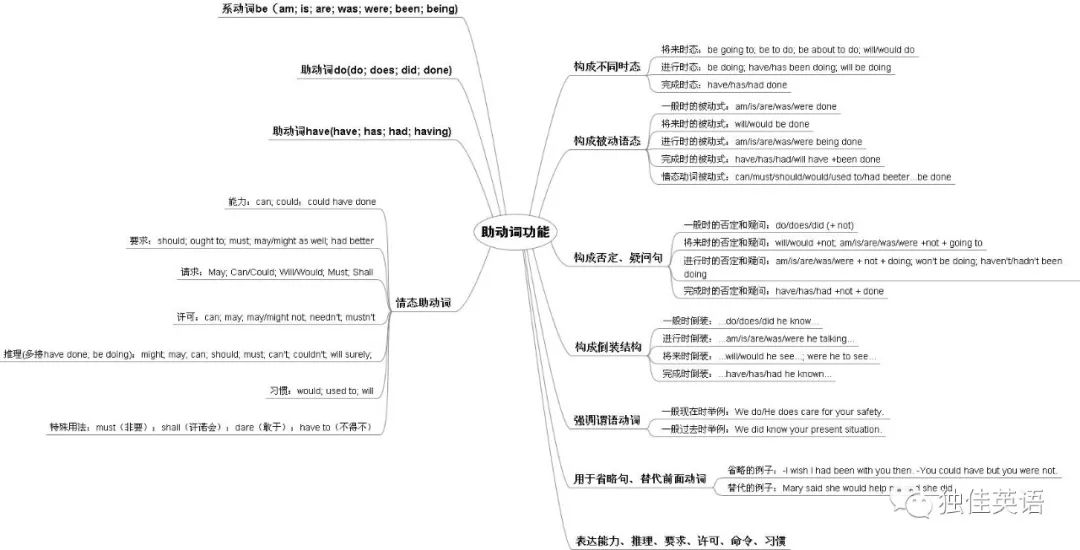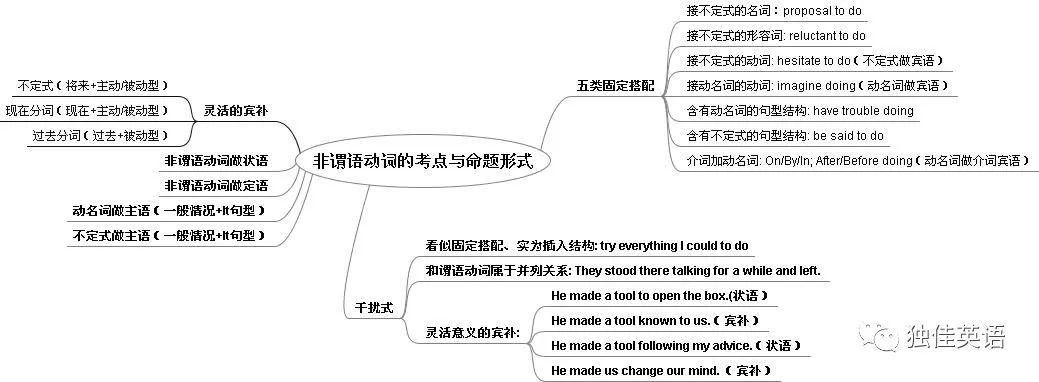
中文的复杂在名词,因为它们表意大半模糊、抽象、笼统;英文的复杂在动词,因为它们具体、精确,分类细致,我们学习所谓“语法”,基本上都是围绕动词的分类展开,所以对于动词基本概念的理解,是基础。大部分学习者的困难,根源在于基本概念没搞明白。
今天的文章,主要介绍我们经常听到看到的、跟动词分类有关的概念。
l 规则动词和不规则动词:
规则动词的过去式、过去分词变化是否加-d或-ed。例如finish——finished(规则动词);
不规则动词的变化:不是加-d或-ed。例如eat——ate(不规则动词)。
l Regular VerbsandIrregular Verbs
A regular verb (also known as a weak verb) forms its past tense and past participle by adding -d or -ed (or in some cases -t) to the base form: "We finished the project."
An irregular verb (also known as a strong verb) doesn't form the past tense by adding -d or -ed: "Gus atethe wrapper on his candy bar."
l 及物动词和不及物动词
及物动词,后面紧跟一个直接宾语。例如sell:She sells seashells.
不及物动词:后面不能直接跟宾语。例如sat这个动词:He sat there quietly.
(这个区别比较简单粗暴,因为很多动词是兼具两个功能的。)
动词的及物性,可以说是99%动词表达错误的源头,它涉及到语态变化、分词使用、介词、句子成分等多方面。
l Transitive VerbsandIntransitive Verbs
Atransitive verb is followed by adirect object: "Shesellsseashells."
Anintransitive verb doesn't take a direct object: "Hesatthere quietly."
(This distinction is especially tricky because many verbs have both transitive and intransitive functions.)

l 短语动词和介词动词
短语动词,是由一个主动词(一般表示行为、运动),加上一个介词副词(就是兼做介词、副词,一般表示方向和位置,这样的副词),例如tear off、pull through;
介词动词,由一个动词加一个介词构成,但它的意义不同于该动词,比如send(派送)和send for(派人去请);rely(信任)和rely on(依赖)。
短语动词意义非常灵活;介词动词改变了元动词的意思。
l a phrasal verb and a prepositional verb
A phrasal verb (such astear offorpull through) is made up of a main verb (usually one of action or movement) and aprepositional adverb--also known as anadverbialparticle(of direction or location).
A prepositional verb (such assend fororrely on) is anidiomaticexpression that combines a main verb and aprepositionto make a new verb with a distinct meaning.

l 助动词和主动词
助动词出现在句中主要动词前面,主要指have、do、will;它和主动词一起构成一个“动词词组(verb phrase)”;它又称为“helping verbs”,这个称呼很形象——帮助主要动词,体现出动词的时态、人称、否定等变化。
主要动词,又叫“实义动词(lexical verbs)”,顾名思义,它决定动词词组的主要意思。
助动词的错用、漏用,是初学者最容易犯的错误。即便是学习英语很久的人,也很难达到“自动化”的熟练程度。这跟我们母语思维的顽固影响有关。例如这样的说法:I not like this movie.
l auxiliary verbsand main verbs
An auxiliary verb (also known as ahelping verb) is a verb (such ashave, do, orwill) that may come before the main verb in a sentence. Together the auxiliary verb and the main verb form averb phrase.
A main verb (also known as alexical verborfull verb) is any verb that isn't an auxiliary verb. The main verb conveys the meaning in a verb phrase.

l 动态动词和状态动词
动态动词,例如run、ride、grow、throw,用来描述一个动作、进程、感知。
状态动词,如be、have、seem、know,用来描述一个状态、情景。
动态动词和状态动词的区分,理解起来比较抽象。我们可以这样说:动态动词表示的是不同状态之间的切换瞬间(如前面的run,是从静止到运动之间的切换;状态动词则是一个状态的持续,例如have(拥有)。
再举一个例子:I know him,这是指“我认识他”这样一个状态;如果要表达“我结识了他”,即从不认识到认知之间的切换,我们必须说I get to know him。
l dynamic verbsand stative verbs
A dynamic verb (such asrun, ride, grow, throw) is primarily used to indicate an action, process, or sensation.
In contrast, a stative verb (such asbe, have, seem, know) is primarily used to describe a state or situation.
(Because the boundary between dynamicWNalmBgE and stative verbs can be fuzzy, it's generally more useful to talk of dynamic and stativemeaningandusage.)

l 限定动词和非限定动词
限定动词,能体现出它和主语之间的一致性(主谓一致),并且体现出时态语态等变化。所以又叫做“谓语动词”。如果一个句子中只有一个动词,它一定是限定动词。
非限定动词,无法体现出时态的变化、也不能在句子中独立存在。所以又叫做“非谓语动词”。它的具体表现形式有三个:不定式、现在分词(-ing)、过去分词(-ed)。
在一个句子中,一个主语,只能有一个对应的谓语动词,如果有两个以上,之间必须有并列连词;但非谓语动词却可以有多个。根据这一点,独佳的句子构成四分法,有对应公式:1、SV(主谓);2:SV+V(主谓+连词+谓);3、SVv(主谓+非谓)。这个对于分析复杂句子结构非常实用。
l finite verb and a non-finite verb?
A finite verb shows agreement with a subject and is marked fortense. (If there's just one verb in a sentence, it's finite.)
A non-finite verb (also called averbal) doesn't show a distinction in tense and can't stand alone as the main verb in a sentence.

l 使役动词、链接动词和连系动词
使役动词,顾名思义,表示“使”某行为发生。一个比较容易记的方法:这类动词的中文译法,总少不了这几个字:使、给、将、把、让、令。注意正是多这几个字,让我们能够区分很多同义词。例如sit(坐)和seat(让某人坐);lie(位于)和locate(使……位于)
链接动词,后面总是和其他动词一起构成一个完整的“动词系列”,例如deserve总是加to do;又如这个句子:Wepromised to agree to try practicing playing tennis more often.这里面的promise、agree总是接不定式;try、practice总是接动名词。独佳英语提供的“最常见常用动词句型表”,归纳了300多个这样的动词。
连系动词,连接主语和它的补语,就是我们常说的“主系表”。台湾有本讲文法的书,很受欢迎,它有个重要观点:认为中国学生学英语语法,最大的困难根源在于这个“连系动词”,这个说法很有道理——我们低估了主系表结构对我们英语思维形成产生的影响。其中最明显一个例子:如果问系动词的例子,估计大部分人说到be、look、sound,基本就很难说下去了。
l Causative verbs,Catenative verbsand Copular verbs
Causative verbs, for example, show that some person or thing helps to make something happen.
Catenative verbs join with other verbs to form a chain or series.
Copular verbs link the subject of a sentence to its complement.

l 施为动词、反复动词和引述动词
施为动词,可以看作是专指“口头行为”的动词。比如promise, invite, apologize, predict, vow, request, warn, insist, forbid这类动词。
反复动词,又称为频率动词、习惯动词,即表示重复动作的动词。英语中这类原由网动词多以-er结尾,如(chatter, patter, stutter);以及-le结尾原由网,如babble, cackle, rattle。
引述动词,是指那些引出间接引语的动词,例如say, tell, believe, reply, respond, or ask。
这组区分看似和句法关系不大(除了reporting verbs),但是对动词分类记忆,还是很有帮助的。例如stammer,假如不认识,我们大体可以推测出它跟说有关(stammer:结结巴巴地说)。
l performative verbs, iteratives, and reporting verbs
Aperformative verb is a verbthat explicitly conveys the kind of speech actwww.58yuanyou.combeing performed—such as promise, invite, apologize, predict, vow, request, warn, insist, and forbid. Also known as speech-act verb or performative utterance.
An iterative is a verb or verb form indicating that an action is (or was) repeated. Also called frequentative, habitual verb, iterative activity, and iterative aspect.In English grammar, several verbs ending in -er (chatter, patter, stutter) and -le (babble, cackle, rattle) suggest repeated or habitual action.
Areporting verb is a verb (such as say, WNalmBgEtell, believe, reply, respond, or ask) used to indicate that discourse is being quoted or paraphrased. It's also called a communication verb.






